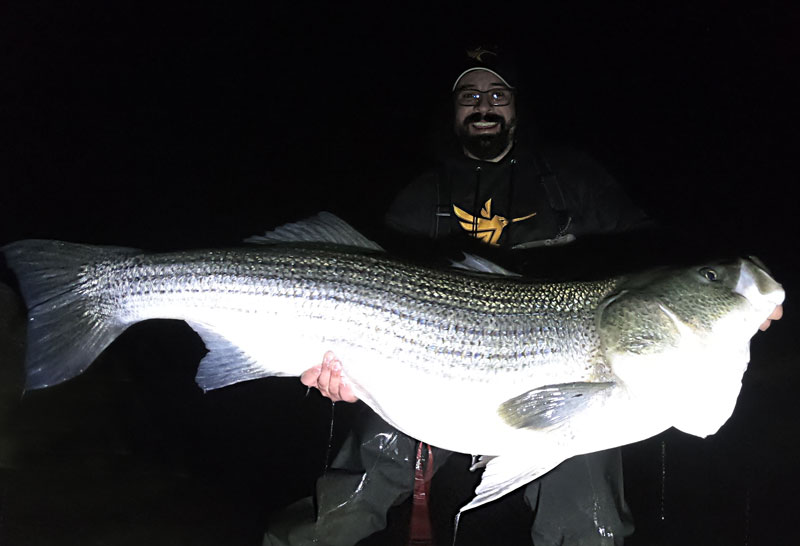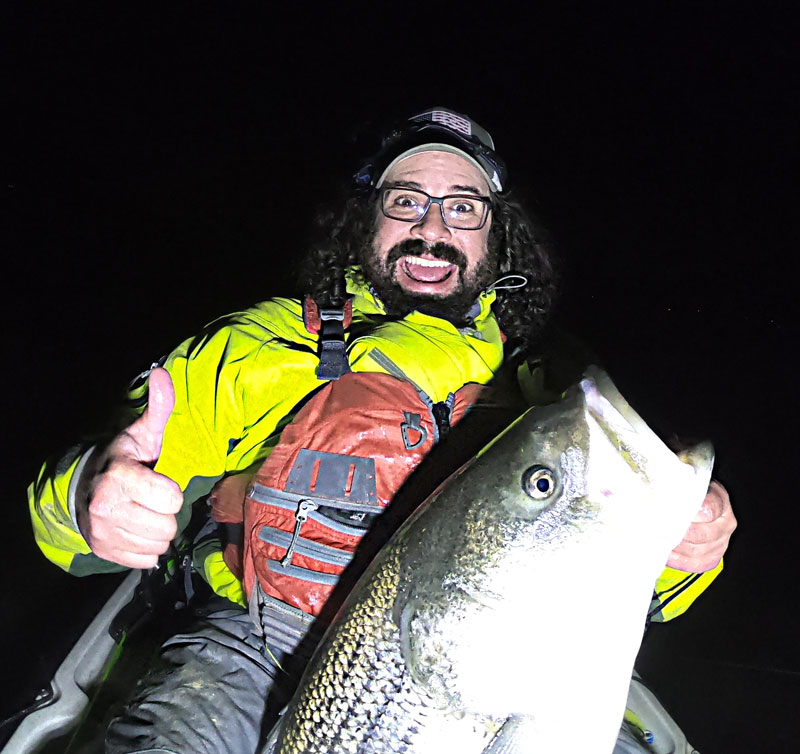It’s one a.m. The winds howl as ice forms on the surface of the Bay under the crisp black sky. The rest of the world sleeps, but a few bleary-eyed, battle tested anglers overcome the somatic calls to rest. Every urge — except the one to fish the full moon tides — begs the angler to stay in the comfort of his home. We call this time the “inhuman hours” because of the discomfort in this environment. Why endure this time when there are plenty of comfortable hours in the day to fish?! I’ve been trying to answer this question for as long as I can remember… and I’ll attempt to explain what I’ve uncovered as it pertains to striped bass.

I need to preface this article with some assumptions because there are exceptions to every observation. This discussion focuses on the shallow water fishery where light penetrates the entire water column, not a deeper water fishery where the depths attenuate light and fish may stay highly active throughout the brightest periods of the day.
Over the years I patterned areas both in the daytime and the nighttime, and the differences are, well, night and day. Consider the last time you walked through the woods at midday, feeling as though the area was barren of life, only to return at dusk as everything comes alive. The water is that way too. You can hear it happening all around. Bait skims the surface, interrupted by larger splashes of predators in pursuit. The sounds envelop you, and if you weren’t wiser, you’d believe ghosts haunted the darkness. Because humans can’t see well in the dark, the Humminbird MEGA Side Imaging and, more recently, MEGA Live Imaging sonar has really helped understand the magic happening below. Using these tools, I remained in an area for 24 hours and used them as my “eyes” to try to understand what happens.
At midday, very little happens. Seldom does life show itself on either the surface or on side imaging. As the sun falls lower in the sky, baitfish slowly arrive, marking the first signs of life. The late afternoon just before dark is one of the most productive times to catch a striper in the shallows, but the window is small and you have to be at the right place at the right time. As the sun disappears and night takes over, baitfish numbers increase dramatically, even blacking out the sonar at times.
Then the splashing begins as war breaks out.
This occurs throughout the night, with increased activity at the best tides. The first glow of daylight brings another key opportunity, and it also seems to mark the time when bait begins to leave the shallows, which perhaps drives a striper to get a last easy meal. After a few hours, the bait completely vacates the area and the cycle begins again.
Consider this baitfish behavior, combine it with tidal cycles and the coming and going of daylight, then add in your ability to see through the night with your electronics, and you may have a good idea why you’d want to fish through the darkness. These magic windows are hard to hit at only dusk or dawn. And even if you miss the magic windows, your odds of catching are still better at night than during peak brightness at midday.

That prolonged ability to target fish improves your odds of success, however, reduced visibility comes with a multitude of safety concerns. Hitting floating or unlit hazards tops the list. Another issue of fishing in the darkness is that it’s hard. It’s hard to tie knots, cast to spots, find lures in your box — pretty much everything is harder without light. You must prepare for that with auxiliary lighting. I carry both a lantern and a headlamp in addition to a downward shining light that illuminates my vessel. All of these typically remain off so as to not alert the fish. Turning them on when moving from place to place alerts other vessels to your position (especially if in a kayak) and helps you see very nearby hazards. With your headlamp, you can even light up vessels that may be coming too close for comfort. I have been amazed at the lack of required navigation lights on small vessels venturing out at night and even in a slow kayak, I’ve nearly hit unlit vessels because it’s just impossible to see them.
I’ve taken a very simplistic approach in describing the advantages of targeting striped bass at night, discussing only food and tides, without going into how a striped bass has evolved to take an unfair advantage over its prey. And I’ve done so because as anglers we really only care about catching fish by imitating its food. Understanding when maximum feeding behavior occurs maximizes the chances of catching fish, especially the biggest fish that seemingly only exist in the shadows.
From my experience, catching hundreds of very large striped bass in shallow water, a rough average of 95 percent have come at low or no light conditions. For some reason, the fish do feed throughout the day at times. But statistically speaking, anglers are wise to stick with the timeframes that maximize their chances. This opportunity for the catch of a lifetime is why the bleary-eyed angler leaves all the comforts of home, ignoring all other instincts and braving the darkness, cold, and danger to fish the inhuman hours.
- By Alan Battista, author of “Light Tackle Kayak Jigging the Chesapeake Bay,” “Light Tackle Kayak Trolling the Chesapeake Bay,” and “Light Tackle Fishing Patterns of the Chesapeake Bay.”
Editor’s Note: The USCG regulations stipulate that oar-powered vessels, including kayaks, “exhibit an all-around white light or have ready an electric torch or lighted lantern showing a white light which shall be exhibited in sufficient time to prevent a collision.” Regardless, as a matter of safety we’d recommend always having some form of illumination visible from all angles, at all times. Note that powered kayaks with motors (including electric) fall into the category of powerboat lighting requirements and must have red/green sidelights and a stern light illuminated while underway.